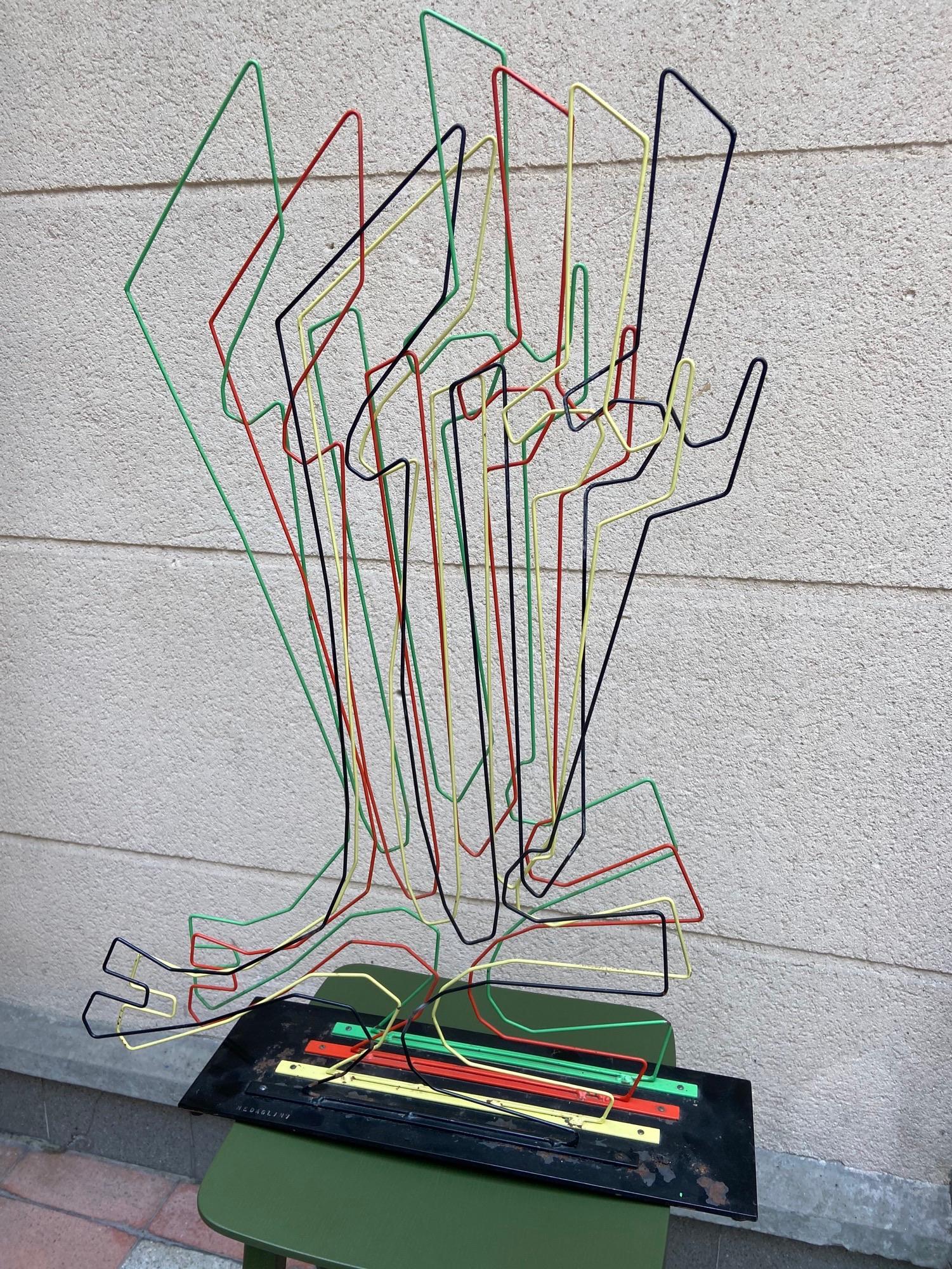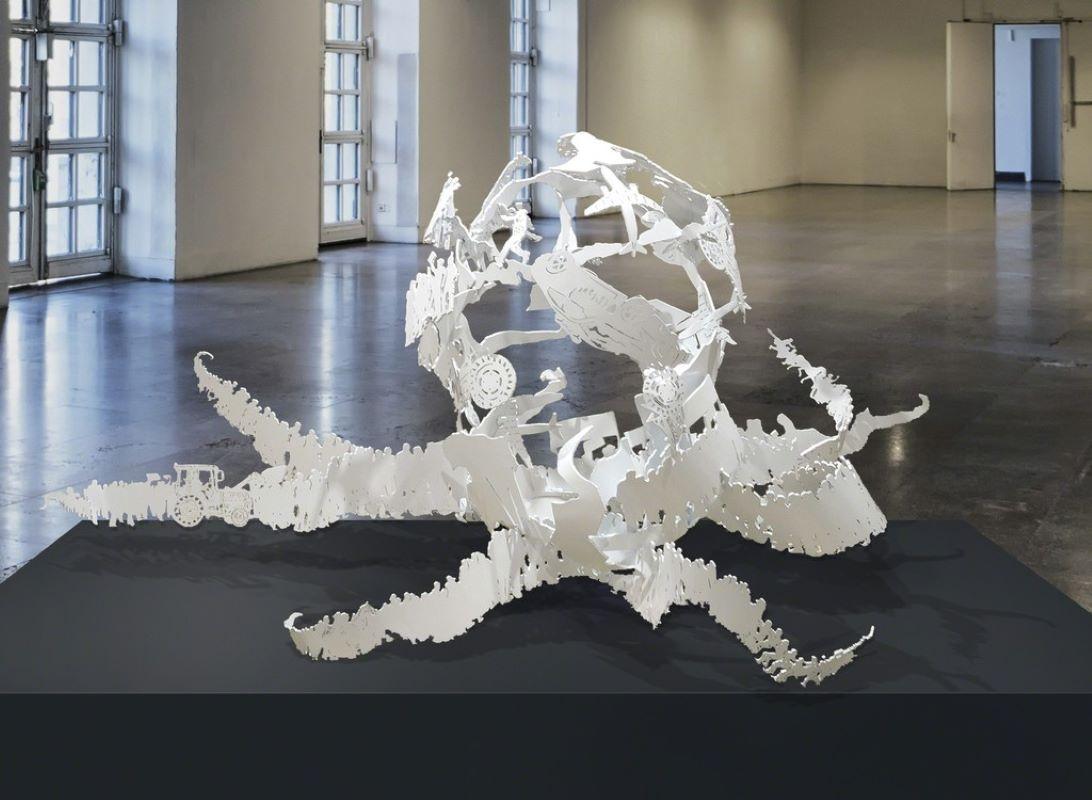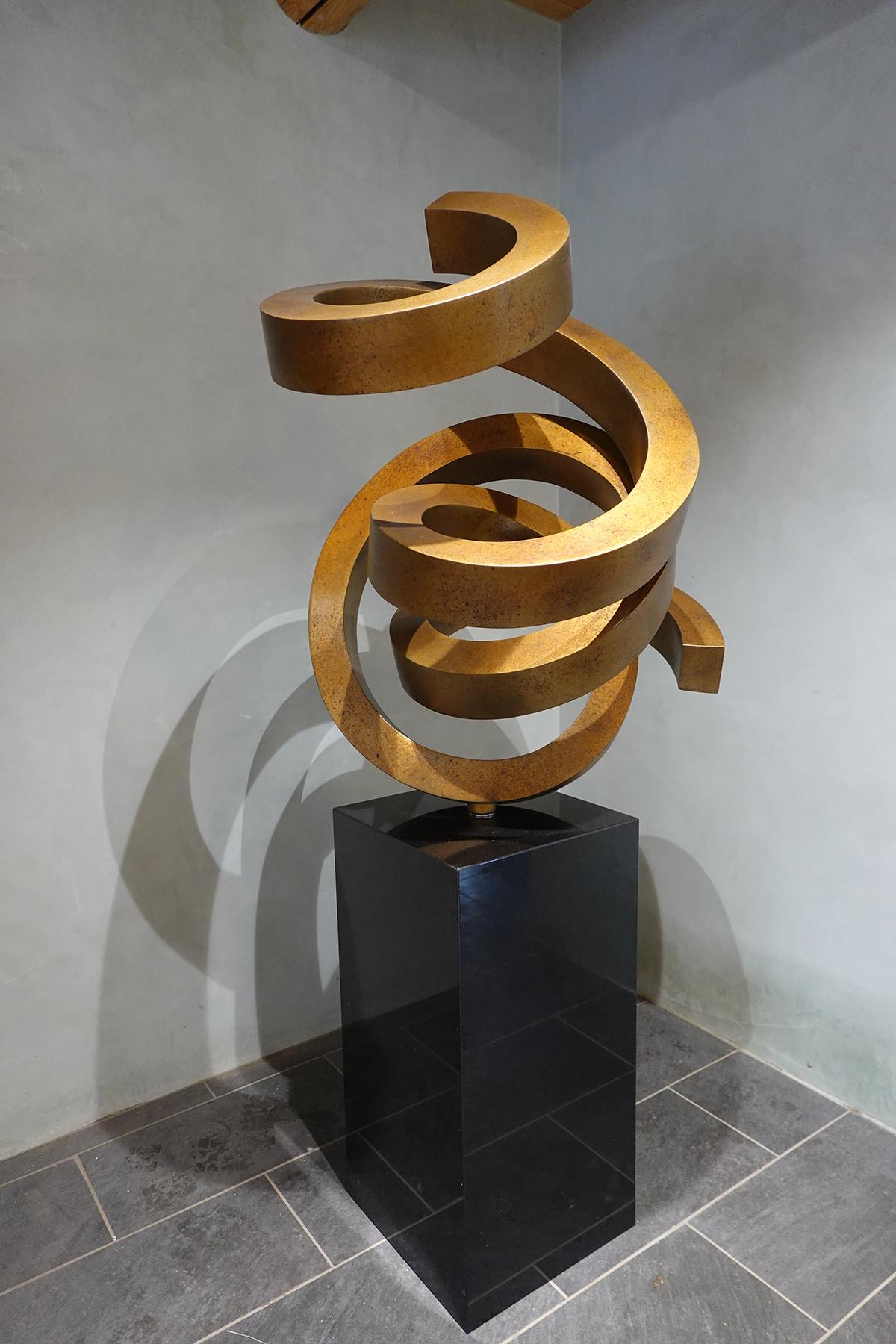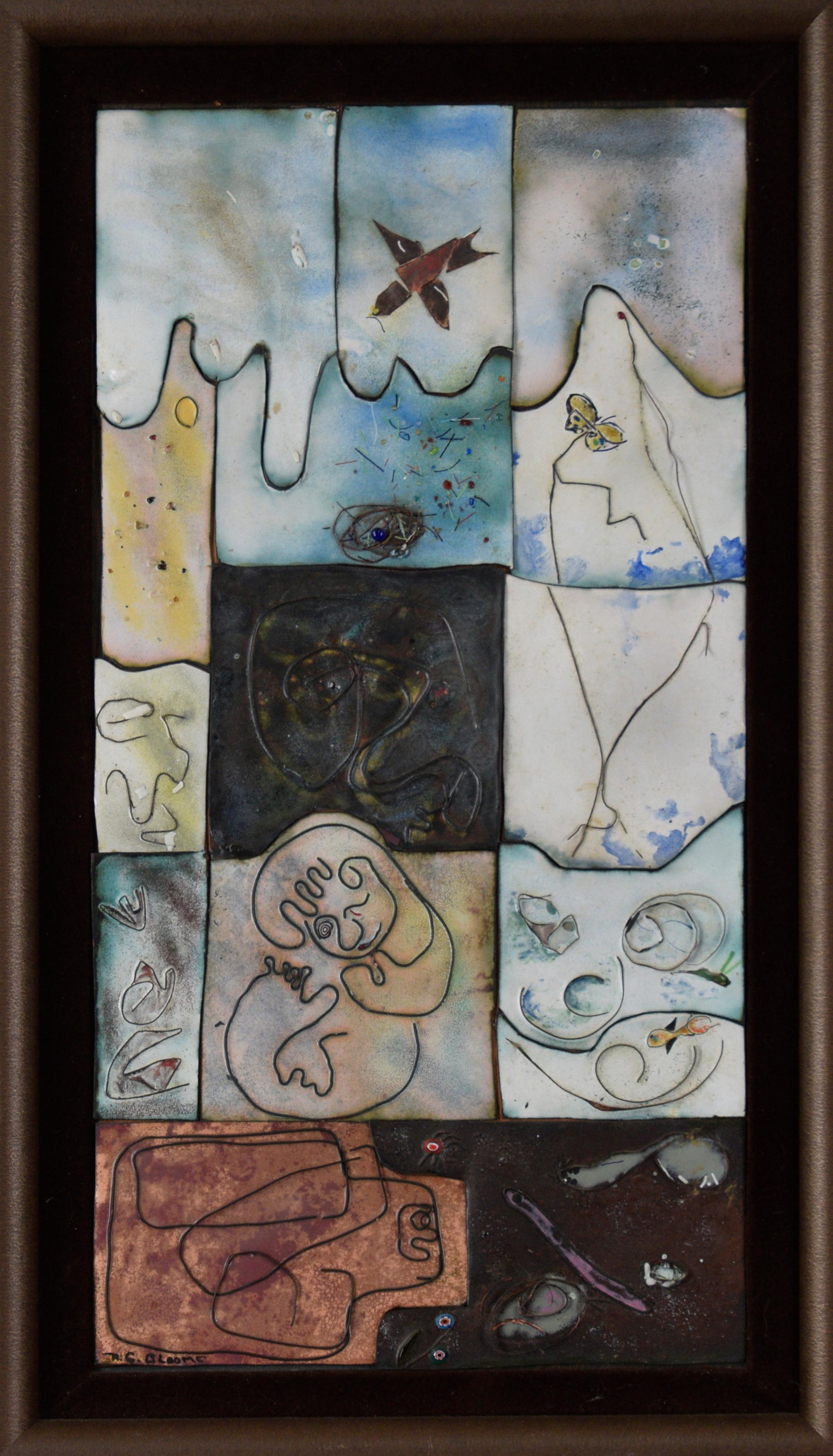Items Similar to Banner (abstract expressionist sculpture, Tulsa OK artist)
Want more images or videos?
Request additional images or videos from the seller
1 of 11
Duayne Hatchett Banner (abstract expressionist sculpture, Tulsa OK artist)1958
1958
About the Item
Duayne Hattchett ((1925-2015). Banner, 1958. Welded metal, sculpture measures 11 h. x 9 w. x 3.75 d. inches. Measuring a total of 17.5 inch high on base. Base measures 5.5 x 5.5 by 6 inches h. Signed, dated, titles on bottom of base. Excellent condition with no damage or conservation.
Duayne Hatchett was a visual artist whose work included prints, paintings, sculpture, and found objects. He was born on May 12, 1925 in Shawnee, Oklahoma. He enlisted in the Air Force where he trained to become a fighter pilot. After leaving the military he studied design at the University of Oklahoma. His highly technical military training combined a mathematical intelligence with a love for physics and a daring embrace of new experience, all of which would soon be the tools for his evolution through art.
Two major influences interacted on his early development at OU. Emelio Omero, a colleague and close friend of Diego Rivera, introduced him to the revolutionary art ideas of Mexico City, while teaching him a wide range of printing techniques that would culminate in a Masters Degree in Painting in 1952. During this time he met Bruce Goff, a renowned Wright disciple, who was teaching architecture at OU and befriended Hatchett, introducing him to the most avant-garde architecture of that time.
He spent his summers while at OU designing for a small sign shop, which introduced him to new materials used for building neon, plastic, and metal signs. The use of new materials and a keen sense for design would soon become invaluable building blocks for future sculpture. During this time he met and married Mary Ellen Jeffries. They would spend their lives together and raise three children, David (me), my brother Dana, and my sister Jeffri. As children, they were immersed in art from childhood and benefited greatly from this loving art and domestic environment.
Hatchett was always interested in the techniques of construction, often watching different tradesmen working, understanding how materials are put together to create the manmade environment that surrounded him. While teaching printmaking at Oklahoma City University from 1951 through ‘54, he began to build sculpture employing some of the materials and techniques that he saw workers using. He was beginning to draw the attention of architects and he became interested in their work-trade processes, moving from blue prints to construction.
He accepted an invitation from Alexander Hogue to teach sculpture at Tulsa University in 1954. He moved his family to Tulsa where he would teach for the next ten years.
While in Tulsa, he became well known as a teacher and a sculptor, often lecturing at various sculpture conferences around the country. He also began to obtain commissions for sculpture as his interaction with architecture continued to evolve. He began to meet and interact with some of the most influential New York artists, including David Smith, Louise Nevelson, Noguchi, and Chicago artist, Richard Hunt.
The 'found object' became important subject matter for many artists including Hatchett and his frequent trips to junkyards yielded the materials for welded sculptures that explored abstract forms suggestive of the world around him. Sources of inspiration ranged from a dead cat smashed on the road to Sputnik orbiting the earth. Alan Stone Gallery in New York City, arranged to show two of these pieces at the Museum of Modern Art in 1963.
He was offered a teaching job at Ohio State University in 1964, where he would teach sculpture for the next three years, and make a leap of imagination that would propel his art into the museums and galleries in New York City and beyond. He began by moving away from combining found objects to using found materials to fabricate objects that he called "Totems." Royal Marks Gallery in New York City began to represent Hatchett in 1964 and arranged for him to be included in the ‘Young American Sculpture East to West’ show representing the United States in the 1964 New York World’s Fair. He would then leave any hint of the found object or junk material behind (until the 90’s) and move into pure abstraction, what can only be described as 'Modern' Art.
Taking his cue from modern architecture, he began to draw simplified volumes and planes, minimally rendered, so as to be easily grasped as a whole. Built with industrial materials, sheet metals and plastics, the images suggested the look of modern technology and architectural accuracy in the environment. These new works resulted in multiple one-person shows, including shows at Royal Marks Gallery in 1965, ’68, ’69, and ’70, and defined a major shift in his work that would be played out for the next two decades. He was featured on the cover of the Whitney Annual and the Whitney Museum acquired a large sculpture in 1967. He was included in the American Sculpture of the Sixties show at the Los Angeles County Museum and the Pittsburgh International, at the Carnegie Institute Museum of Art that same year.
In 1968 he took a teaching position at the University of Buffalo where he would head the sculpture department for the next 24 years and he would move his art in multiple directions. He began a series of paintings to exploit the simple line drawings previously used to define the plate metal sculpture. These paintings explored the optical relativity of two and three-dimensional space depicted on a flat plane. He was also continuing to develop his geometric minimalist sculptures, landing several sculpture commissions around the country. In 1974, the Albright-Knox Art Gallery in Buffalo, NY presented, Duayne Hatchett: Recent Paintings and Sculpture. In the ensuing years his work would be shown in one person and group shows around the country. In the studio, the confluence of construction and the 'Found Object' re-entered his work in a completely unexpected way. Construction itself became the creative engine transforming his new art.
New tools and working processes were adopted or invented to create new art. The trowel would replace the brush for building new paintings. Tools for rolling and burnishing metal would be invented and riveting would be adopted to build new sculptures. He was influenced by the characteristics of materials and objects such as corrugated sheet metals, the optical effects of plastics, metal grates, tin cans, seen in his man made environment, as well as crosscut tree logs and drift wood from his natural environment. He began to build sculptures, in the privacy of his studio, largely unseen by the public.
In the late 90’s, the found object re-emerged in the form of new sculpture created from railroad spikes welded together to form organic conglomerations reminiscent of nature. He also began to build assemblages of found objects and materials that maintained a continuous flat surface, which were simultaneously sculptures as well as being blocks for prints. By utilizing a wide range of printing techniques that he invented, he made mono-prints that record the image of the assembled material constructions, greatly extending his previous uses of the found object, and greatly expanding the imagery in his printmaking.
From printmaking and painting of the late 40’s, influenced by Mexican Art, through the junk metal used from found objects in the 50’s and early 60’s, through the minimalist sculpture and paintings influenced by modern architecture from the 60’s and 70’s, to the paintings, sculpture and printmaking of the last forty years, Duayne Hatchett has developed a personal expression that solicits a universal response. His unique visual language has been created through the invention of tools, the manipulation of various materials and objects, which he presents in a unified form. These expressions reflect our environment, specifically and generally, as objects once in use or patterns at play. Hatchett’s art works are interactive vessels that hold their content as potential energy, waiting to unlock our memories and our senses through the act of observation.
- Creator:Duayne Hatchett (1925 - 2015)
- Creation Year:1958
- Dimensions:Height: 17.5 in (44.45 cm)Width: 9 in (22.86 cm)Depth: 3.75 in (9.53 cm)
- Medium:
- Movement & Style:
- Period:
- Condition:
- Gallery Location:Wilton Manors, FL
- Reference Number:1stDibs: LU245214037752
About the Seller
4.9
Gold Seller
These expertly vetted sellers are highly rated and consistently exceed customer expectations.
Established in 2007
1stDibs seller since 2015
328 sales on 1stDibs
Typical response time: 9 hours
- ShippingRetrieving quote...Ships From: Wilton Manors, FL
- Return PolicyA return for this item may be initiated within 7 days of delivery.
More From This SellerView All
- Two Untitled CompositionsLocated in Wilton Manors, FLFumio Otani (Japanese, 1929-1995). Untitled and Untitled, ca, 1965. Cast and polished steel. Smaller composition measures 14.75 x 7.75 x 1.5 inches. Larger composition measures 16...Category
Mid-20th Century Abstract Expressionist Abstract Sculptures
MaterialsSteel
- Reaching (bronze hand)Located in Wilton Manors, FLReaching, ca. 1980. Cast bronze. Signed in lower region on wrist. A rare example from the artist's later period influenced by figurative abstraction with expressionist tendencies. James Edward Lewis (August 4, 1923 – August 9, 1997) was an African-American artist, art collector, professor, and curator in the city of Baltimore. He is best known for his role as the leading force for the creation of the James E. Lewis Museum of Art, an institution of the HBCU Morgan State University. His work as the chairman of the Morgan Art Department from 1950 to 1986 allowed for the museum to amass a large collection of more than 3,000 works, predominantly of African and African diasporan art.[1] In addition, he is also well known for his role as an interdisciplinary artist, primarily focused on sculpture, though also having notable examples of lithography and illustration. His artistic style throughout the years has developed from an earlier focus on African-American history and historical figures, for which he is most notable as an artist, to a more contemporary style of African-inspired abstract expressionism. Early and personal life James E. Lewis was born in rural Phenix, Virginia on August 4, 1923 to James T. Lewis and Pearline (Pearlean) Harvey.[5] Lewis' parents were both sharecroppers. Shortly after his birth, his father moved to Baltimore for increased job opportunity; James E. was subsequently raised by his mother until the family was reunited in 1925. They lived for a short time with distant relatives until moving to a four-bedroom house on 1024 North Durham Street in East Baltimore, a predominantly African-American lower-class neighborhood close to Johns Hopkins Hospital. Lewis' primary school, PS 101, was the only public school in East Baltimore that served black children. Lewis grew up in a church-going family, his parents both active members of the Faith Baptist Church, devoting the entirety of their Sundays to church activities. His parents worked a variety of different jobs throughout his youth:[6] his father working as a stevedore for a shipping company, a mechanic, a custodian, a mailroom handler,[6] and an elevator operator.] His mother worked as both a clerk at a drugstore[7] and a laundress for a private family.[4] Lewis' primary exposure to the arts came from Dr. Leon Winslow, a faculty member at PS 101 who Lewis saw as "providing encouragement and art materials to those who wanted and needed it." In fifth grade, Lewis transferred to PS 102. Here, he was able to receive specialized Art Education in Ms. William's class under the guidance of Winslow. He was considered a standout pupil at PS 102 as a result of his introduction to the connection between the arts and the other studies. His time spent in Ms. Pauline Wharton's class allowed for him to experiment with singing, to which he was considered a talented singer. His involvement in this class challenged his earlier belief that singing was not a masculine artistic pursuit. He was able to study both European classics and negro spirituals, which was one of his earliest introductions to arts specific to American black culture. Under Ms. Wharton's direction, he was also involved in many different musical performances,[6] including some works of the Works Progress Administration's Federal Theatre Project.[8] Lewis attended Paul Laurence Dunbar High School, where his love of the arts was heightened through his industrial art class with Lee Davis...Category
Mid-20th Century Abstract Expressionist Abstract Sculptures
MaterialsBronze
- Abstract FigureBy Raul DiazLocated in Wilton Manors, FLRaul Diaz (Argentina, b.1950). Abstract Figure, ca. 1970s. Canved Walnut. Measures 17 inches tall including wood base. Carved signature in lower region. Excellent condition. An ear...Category
1970s Abstract Expressionist Abstract Sculptures
MaterialsWalnut
- Greek Guitar PlayerLocated in Wilton Manors, FLBeautiful abstract sculpture depicting a guitar player. Bronze on wood base measuring 15 x 9 x 4 inches. Actual cast piece without base measuring 17 x 7 x 3 inches. Signed indistinct...Category
Mid-20th Century Abstract Abstract Sculptures
MaterialsBronze
- NexusBy Jack YoungermanLocated in Wilton Manors, FLAbstract sculpture by American artist, Jack Youngerman (b.1926). Nexus, 1990. 24.5 inches. Aluminum, numbered 2/3. Signed and numbered on base. 1926 Born, St. Louis, Missouri; moved with family to Louisville, Kentucky in 1929 1943-44; 1946-47 Attended University of Missouri 1944-46 U.S. Navy, University of North Carolina 1947-49 Ecole des Beaux-Arts, Paris 1949-55 Lived and worked in Paris 1956 Returned to the United States; lived in New York City 1956-1995 1995-current Resides in Bridgehampton, New York ONE MAN EXHIBITIONS: 1951 Galerie Arnaud, Paris 1958 Betty Parsons Gallery, New York (1960, 1961, 1964, 1967, 1968) 1959 Museum of Modern Art, New York, "Sixteen Americans" 1962 Galerie Lawrence, Paris (also 1965) 1963 Galeria dell' Ariete, Milan Everett Ellen Gallery, Los Angeles, California The Phillips Collection, Washington, D. C. 1971 Pace Gallery, New York (also 1972, 1975) 1972 Portland Center for the Arts, Oregon Seattle Art Museum, Washington 1973 The Arts Club of Chicago, Illinois Galerie Denise Rene, Paris 1975 Hopkins Center, Dartmouth College, Hanover, New Hampshire 1976 Parrish Art Museum, Southampton, New York 1981 Washburn Gallery...Category
1980s Abstract Abstract Sculptures
MaterialsAluminum
- Untitled (Organic abstract bronze sculpture)Located in Wilton Manors, FLKlaus Ihlenfeld (b.1934). Untitled, ca. 1960. Welded bronze. 8" h.; 5.5 " w; 3.25" d (base). Signed with initial under base. Provenance: Directly from estate of Harry Bertoia. The ...Category
Mid-20th Century Abstract Abstract Sculptures
MaterialsBronze
You May Also Like
- Sculpture A16 Projection and vibration - MedagliniLocated in Saint Ouen, FRSculpture A16 Projection and vibration - Medaglini (1939-2011) Drawn iron and cast iron base H90xW62xD17 Signed on the base Circa 1975 490€Category
1970s Abstract Expressionist Abstract Sculptures
MaterialsSteel
- Concussion GardenBy Dionisios FragiasLocated in New York, NYDionisios Fragias is a New York -based artist born on the Greek island of Kefalonia and raised in New York City. He is the protege of the artist Jeff Koons whose years-long mentorshi...Category
2010s Abstract Expressionist Abstract Sculptures
MaterialsSteel
- The Afterparty (Octopus)By Dionisios FragiasLocated in New York, NYDionisios Fragias is a New York -based artist born on the Greek island of Kefalonia and raised in New York City. He is the protege of the artist Jeff Koons whose years-long mentorshi...Category
2010s Abstract Expressionist Abstract Sculptures
MaterialsSteel, Stainless Steel
- CycloneBy Gino MilesLocated in Boca Raton, FL46 x 32 x 32 inch bronze sculpture on 32 x 16 x 16 inch black granite baseCategory
21st Century and Contemporary Abstract Expressionist Abstract Sculptures
MaterialsBronze
- Multifaceted Copper Enamel Tiles Abstract by N.G. BloomeLocated in Soquel, CAMultifaceted Copper Enamel Tiles Abstract by N.G. Bloome Enameled Copper panels "Picasso" esq by an unknown artist. N.G. Bloome (American, 20th C). Uniq...Category
1980s Abstract Expressionist Abstract Sculptures
MaterialsCopper, Enamel, Wire
- Untitled signed sculpture, from the collection of Dick Polich, Tallix FoundryBy Stephen TalasnikLocated in New York, NYStephen Talasnik Untitled sculpture, from the collection of Dick Polich, Tallix Foundry, ca. 1997 Cast light metal signed by the artist on the work (see close up photograph) 6 3/5 × 12 × 4 inches Provenance Estate of Dick Polich, founder of the legendary Tallix Foundry and Polich Art works Beacon, NY Manufacturer Stephen Talasnik at Tallix Foundry, Beacon, New York This work is signed by the artist (see close up photograh) Abstract metal sculpture The work is lightweight so it is believed to be in aluminum or an aluminum alloy, Provenance: acquired from the Estate of Dick Polich - founder of the legendary Tallix foundry and Polich Art Works. Polich and Tallix fabricated significant sculptural works over many years, collaborating with such as, Willem de Kooning, Jeff Koons, Roy Lichtenstein, Frank Stella, Helen Frankenthaler, ERTE, Julian Schnabel, Richard Artschwager, Isamu Noguchi, Isaac Witkin...Category
1990s Abstract Expressionist Abstract Sculptures
MaterialsMetal





